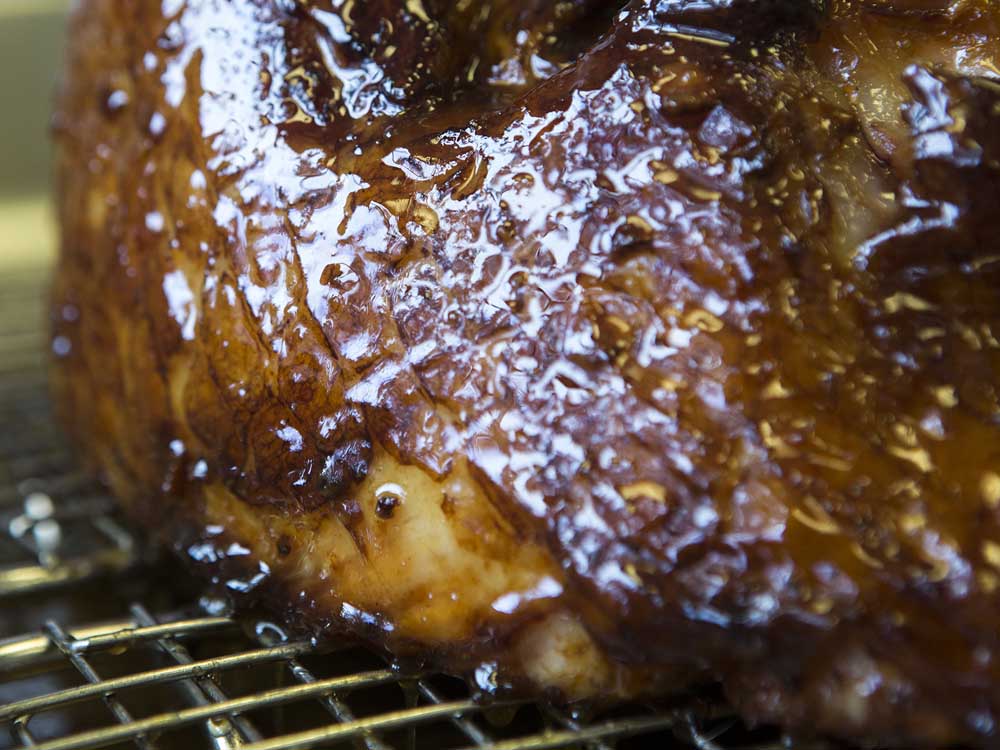Cook Like a Chef: Baked Ham
Published 3:21 pm Tuesday, December 27, 2016

- Tess Freeman/ The Bulletin Cascade Culinary Institute Chef Instructor Thor Erickson uses his homemade glaze recipe for his Easter ham. When the ham gets that shiny, lacquered look that's when you know it's done.
The traditional centerpiece of Easter dinner is a big baked ham, shiny with a sweet and savory glaze. When you cook it like a chef, it’s a memorable meal with tasty leftovers.
Today’s chef instructor from the Cascade Culinary Institute at Central Oregon Community College is Thor Erickson.
Trending
“My philosophy about ham is, you can never have too much ham. The leftovers are going to be great for sandwiches, soup, omelets,” Erickson said.
The ham you buy is already cooked, so your task is to warm it up correctly and make a homemade glaze, even though a plastic bag of glaze will no doubt come with your ham.
“When you open up your ham, throw that bag of glaze away as fast as you can. It’s just a bunch of junk in there: corn syrup and a bunch of hooey,” said Erickson with a laugh.
Erickson’s homemade glaze recipe (Page D2) includes brown sugar, Dijon mustard, riesling wine, apple cider vinegar and a hint of cloves.
“The flavor in this ham is good from all directions. You get salty, you get smoky, you get sweet, you get a little spice, you get a little acid, and so it’s pleasing on all fronts. That’s what I like about this particular recipe. It goes well with most any side dish, whether that’s an Easter classic like scalloped or au gratin potatoes or steamed asparagus. It compliments them all. With this type of ham, simple is the way to go with the vegetable accompaniment. The ham is the lead singer of the group,” Erickson said.
Choosing the ham
Trending
Erickson said to buy a ham with a bone in it. For the classic glazed ham, choose the wet-brined ham that Erickson refers to as “city ham.”
“Ninety percent of the hams in the stores for Easter have the foil on the outside and might say “water added.” Spiral cuts are great, because you just make one lateral cut and you have slices,” he said.
You’ll have two choices: shank end or a sirloin or “butt” end. The butt end is leaner, and the shank end will have a little more fat on it.
“I’m a shank end kind of guy. That fat helps baste the ham in the oven,” he said.
The other kind of ham you’ll find most often in the grocery is a country ham.
“They’re more expensive, and they’re dry brined. Both the ‘city’ and ‘country’ hams are smoked, but country hams are smoked for a longer period of time. That’s a Kentucky Derby ham, not an Easter ham. The country ham is much saltier, with a drier texture, and it’s not the classic glazed ham,” Erickson said.
Into the oven
The recipe is for a ham to come right out of the refrigerator and into the preheated oven. There’s no need to let the ham come to room temperature.
Put the ham in a roasting pan with a rack underneath it. Cover it with foil, and then prepare the glaze.
Glazing
After the ham has been in the oven for one hour, brush half the glaze on it, and then remove the foil while the ham cooks for 10 minutes more. Brush the rest of the glaze on the ham, and return it to the oven for 15 minutes, or until the glaze begins to shine.
“When you brush the glaze on the ham, don’t walk way. There’s sugar in it. You don’t want to burn the glaze. Keep an eye on it, and when it turns to that nice shiny glaze — when it gets that lacquered look — then take it out and let the ham rest, uncovered,” Erickson said.
If you’d like to make a sauce to serve at the table, pour the pan juices into a glass measuring cup and allow the fat to rise to the top for a few minutes. Skim the fat off and discard it. Pour the remaining juices into a small saucepan to reduce. Add a tablespoon of cornstarch, mixed with two tablespoons of water to thicken it.
“You could also add a few pieces of fresh cut up pineapple to the bottom of the roasting pan while the ham is warming up to soak up some of those ham drippings. Just don’t add so many that they block the airflow under the rack. You don’t want to steam the ham.
“The cooked pineapple would be nice and savory, smoky and sweet. Those could be crushed up and made into a chutney style sauce to go with the ham,” Erickson said.
Cooking like a chef means learning tried-and-true techniques and repeating them. Warming up a baked ham properly, so it’s moist and tender, and topping it with a fresh, homemade glaze is relatively easy, but can be tricky.
“In culinary school, we have a saying: When a student succeeds at something like a hollandaise sauce and says, ‘Yes, I finally did it,’ we say, ‘When you do it a thousand more times, then you know you can do it,’” Erickson said.
“I’m a big believer in ‘mise en place,’ which means ‘everything in its place,’ and not just all the ingredients for the recipe. It means being prepared. Read the full recipe. Understand how the ingredients need to work together,” Erickson said. “It makes you a more successful cook, and don’t be afraid to try new things.”
— Reporter: ahighberger@ mac.com
Editor’s note: Cook Like a Chef is a feature designed to help you master cooking techniques that will give your homemade meals professional style and carefully crafted flavor. Each month, a chef instructor from Cascade Culinary Institute at Central Oregon Community College walks us through a skill or recipe.
Baked Ham (10-12 servings)
1 whole Fully Cooked Bone-in Ham (10-12 Pounds), spiral cut is fine
Glaze:
2 cups light brown sugar
1/3 cup Dijon mustard, like Grey Poupon
2 cups Riesling wine (sweet)
3 Tablespoons apple cider vinegar
¼ teaspoon ground cloves
Preheat the oven to 325° F.
Remove all packaging from the ham: foil, plastic, netting, plastic disk at the bone end. We don’t want any plastic in the oven.
Place the ham in a large roasting pan with a rack, cover loosely with a new piece of foil, and bake for 1.5 to 2 hours—about 10 minutes per pound. If the ham is 15 pounds or greater, preheat the oven to 300° F and roast the ham at that lower temperature.
While the ham is in the oven, heat the brown sugar, mustard, vinegar, wine, and cloves in a small saucepan to a boil, and then turn down the heat and gently simmer, reducing the glaze until it’s thickened to the texture of cream, about 10 minutes.
After the ham has been baking for about 1 hour, remove the foil and brush half of the glaze on the whole ham, and then put the ham back in the oven without the foil.
Ten minutes later, brush on the rest of the glaze. Return the ham to oven for 15 more minutes until the glaze begins to shine. Remove from the oven, and allow the ham to rest for 15-20 minutes before carving.








